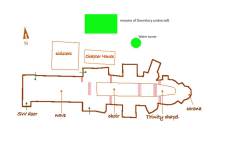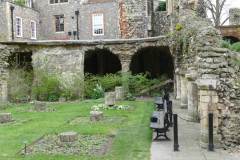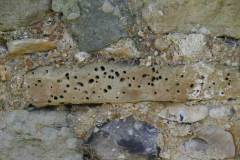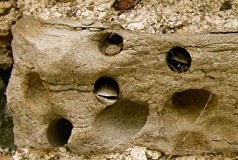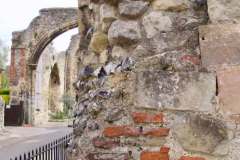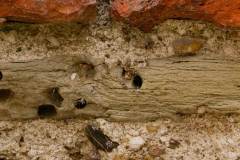Basics
Geology: Thanet Formation
Rock unit: Marine sandstone
Age: Palaeogene
Provenance: Kent coast – Herne Bay to Reculver or Pegwell Bay
Where to see examples
- surviving walls of the dormitory undercroft (images 1-4)
- isolated blocks in the wall of the infirmary (images 5-6)
Description
This stone can be found in the surviving walls of the infirmary, to the north of the Trinity Chapel and in the remains of the east wall of the dormitory. It is present in irregular-shaped blocks of finely-laminated sandstone. These stones are pale-brown and fine-grained with, on occasions, a ‘salt and pepper’ texture caused by small grains of the green iron mineral glauconite.
The sandstones of the Thanet Formation were laid down in marine conditions during the Eocene epoch of the Palaeogene, about fifty eight million years ago. The Formation is named from its reference section at Pegwell Bay where the cathedral stones may have originated. On the other hand the stones may have been collected from where the Thanet Formation outcrops more extensively on the North Kent coast, west of Reculver. Both at Reculver and Pegwell Bay the cliffs yield so called ‘doggers’ of this intermittently hard sandstone. Following erosion of the softer surrounding clays the ‘doggers’ drop onto the foreshore where they can be easily collected by shallow draught boats. Evidence that at least some of the cathedral stones were collected from the foreshore can be found in several examples of sandstone, in which modern bivalve borings can be seen and in some borings the bivalve shell is still extant. The stones were brought to the port of Fordwich by boat via the Wantsum Channel.
Sandstone from the Thanet Formation is not considered to be a good quality building stone. Because of the lenticular shape of the sandstone ‘doggers’ the stone blocks are often irregular in shape and the stones are prone to variable rates of weathering across the fine laminations. The stone has been used at the cathedral as a rubble stone in wall sections that were not intended to be seen. Today it is only where the fabric of the monastic buildings has been despoiled that we see this sandstone exposed to view.

